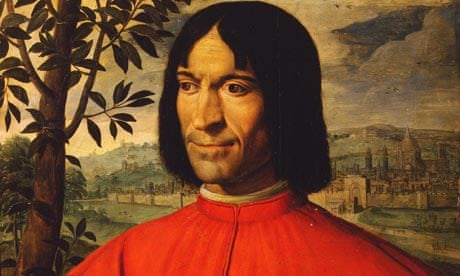In the Sainsbury wing of the National Gallery in London, the founding masterpieces of modern art are arrayed in all their splendour. The modern idea of art – our belief that artworks deserve to be taken seriously not as mere decorations or religious icons but unique displays of imagination and intellect – began in Italy in the Renaissance. The city that was most self-conscious about this new idea of art in the 15th century was Florence, and here in the Sainsbury wing you can see some of the glories of that place and time: the Pollaiuolo brothers' Saint Sebastian, Fra Filippo Lippi's Annunciation, Sandro Botticelli's Venus and Mars.
These artists had something important in common, beyond the fact that they all worked in 15th-century Florence. All of them had close ties with one family: the Medici. The Annunciation panel by Lippi actually comes from the Medici palace, and Antonio del Pollaiuolo painted decorations for this domestic temple of the arts. Botticelli was a Medici protege, who portrays himself among the men of this famous lineage in his Adoration of the Magi in the Uffizi.
The Medici are among the most renowned art patrons in history, and with good reason. But here's a fascinating thing: they are also among the architects of the modern economy. They were the greatest bankers of their age, and the Medici bank pioneered crucial aspects of modern finance. They were "foreign exchange dealers" who enacted a "transfiguration of finance", points out the financial historian Niall Ferguson. When we look at Botticelli's Venus, we are looking at money.
An exhibition at the Strozzi palace in Florence this autumn (24 September, to be precise), called Money and Beauty, will explore this very contemporary aspect of the Medici. This timely show proposes, according to the press release, to "show how the modern banking system developed in parallel with the most important artistic flowering in the history of the western world". It sounds riveting. But there is one aspect of the relationship between art and money in Medici Florence that is deeply enigmatic.
In the Sainsbury wing, you can easily see the fruits of Medici largesse. But what you cannot see, what in fact you rarely find in Florentine Renaissance art, is a brass-tacks portrayal of merchant life.
The Medici chose to have themselves portrayed not working at the bank, but in the robes of the Magi. They commissioned paintings not of the marketplace, but of mythology. There is a glaring contrast between the art of Renaissance Florence, with its passionate recreations of classical myth and history, and the raw realism of northern European portraits of businessmen. Hans Holbein's portrait of a merchant surrounded by the instruments of his trade has no equivalent in the art associated with the Medici family. Why is that?
An answer may lie in the history of the family itself. The Medici bank was brought to the forefront of the European economy by Giovanni di Bicci de' Medici, who died in 1429. His son Cosimo was the richest man in Europe. Yet Cosimo did not earn his honorary title "Father of his country" through financial brilliance. He was given it because he used the wealth of the family business to reshape Florentine politics. That obsession with politics grew until the most powerful and charismatic Medici of all, Lorenzo the Magnificent, let the bank decay while he concentrated on running the Florentine state.
It's a strange irony that Renaissance Florence was built by capitalist innovation, but went out of its way to make money invisible in its art. Politics, not money, dominated this city's culture. The ultimate beneficiary of Medici patronage was Michelangelo, who shared both the Medici instinct for making money and the Medici determination to ignore it. His Moses really has loftier things than money in mind.
The absence of financial imagery in Florentine Renaissance art may even explain why the city went into cultural decline after 1529. The later Medicis completed the change from merchants to aristocrats and even royals. As they made themselves Dukes of Tuscany and intermarried with European royal families, the art and architecture of Florence gradually lost its edge. The moral might be that if money makes art, snobbish disdain for money can kill it.

Comments (…)
Sign in or create your Guardian account to join the discussion